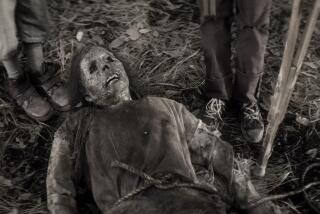Movie review: ‘Nostalgia for the Light’
- Share via
“Nostalgia for the Light” won’t make you nostalgic for anything because it’s not like other documentaries you’ve seen. A film of rare visual poetry that’s simultaneously personal, political and philosophical, it’s a genuine art film that’s also unpretentious and easygoing.
As directed by Chilean director Patricio Guzmán, “Nostalgia” is a completely fascinating meditation on different aspects of the past and the interlinked ways we explore them. This may sound cold and distant but Guzmán’s mastery of cinema means that what sounds artificial turns out to be moving in a surprising, even profound way.
Beginning with the landmark “The Battle of Chile,” that country’s past has always been Guzmán’s subject, specifically the Salvador Allende revolution and the Augusto Pinochet counter-revolution. With this film, he’s found an unusual new way to approach it, a way that goes though a very particular area called the Atacama Desert.
One of the driest places on Earth, devoid of insects, animals or birds and so arid it registers as a parched brown even from outer space, Chile’s Atacama has qualities that make it an accessible gateway to the past, qualities that draw three distinct groups interested in that kind of exploration.
Because he has been interested in astronomy since childhood — the film opens with intriguing images of the still-functional 1910 telescope that inspired him — Guzmán starts with scientists who choose to study the stars from a series of Atacama radio telescopes because the area’s transparent air makes it ideal for that purpose.
“Nostalgia” intersperses ravishing images of the solar system with heady conversations with scientists who let us know that by definition astronomy is the study of the past. For the interplanetary light they study has been traveling for hundreds of thousands of years to get here.
The Atacama has also attracted more conventional explorers of the past, archaeologists who show the filmmaker rock carvings by pre-Columbian shepherds that are more than 10,000 years old.
As Guzmán points out, one of the paradoxes of the Chilean experience is that, in contrast to all the attention paid to the distant past, Chile has been reluctant to confront its immediate past, to look into the large numbers of political opponents liquidated or “disappeared” by the Pinochet regime.
The Atacama plays a part in this too, because this remote desert turns out to have been a dumping ground for bodies of murdered political prisoners. And sharing the desert with astronomers and archaeologists is a third group of searchers, relatives of “the disappeared” who sift through the sands looking for remains of their loved ones.
The connections and reverberations among these three groups is the heart of this film, and it is made especially involving because of the articulate nature of the people Guzmán has chosen to interview and the way he talks to them.
“I don’t like to corner the people in my films into giving me a specific answer,” the director has said in the past. “I usually interview them for hours and hours without ever revealing where the interview is headed.”
When combined with cinematographer Katell Djian’s stunning images, Guzmán’s fluid, unconventional filmmaking deftly explores surprising relationships and meaningful cross-cultural connections among these nominally very different groups of searchers. The result is as emotional as it is unexpected, and that is saying a lot.
More to Read
The biggest entertainment stories
Get our big stories about Hollywood, film, television, music, arts, culture and more right in your inbox as soon as they publish.
You may occasionally receive promotional content from the Los Angeles Times.











